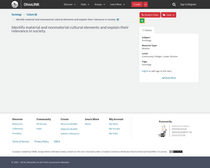Description
- Overview:
- OER Text materialWhat Is Culture? Chapter 3, subsection 3.1. A subsection of this section notes that culture consists of thoughts (expectations about personal space, for example) and tangible things (bus stops, trains, and seating capacity). Then material culture is defined as the objects or belongings of a group of people. Examples of material culture are given as metro passes, bus tokens, automobiles, stores, and the physical structures where people worship. Nonmaterial culture, in contrast, consists of the ideas, attitudes, and beliefs of a society. Material and nonmaterial aspects of culture are linked, and physical objects often symbolize cultural ideas. A metro pass is a material object, but it represents a form of nonmaterial culture, namely, capitalism, and the acceptance of paying for transportation. Clothing, hairstyles, and jewelry are part of material culture, but the appropriateness of wearing certain clothing for specific events reflects nonmaterial culture. It is noted that material and nonmaterial aspects of culture can vary subtly from region to region. As people travel farther afield, moving from different regions to entirely different parts of the world, certain material and nonmaterial aspects of culture become dramatically unfamiliar.
- Subject:
- Sociology
- Level:
- Community College / Lower Division
- Material Type:
- Module
- Provider:
- Ohio Open Ed Collaborative
- Date Added:
- 07/03/2018
- License:
-
Creative Commons Attribution Non-Commercial Share Alike

- Language:
- English
- Media Format:
- Text/HTML
Standards
Evaluations
No evaluations yet.


Comments